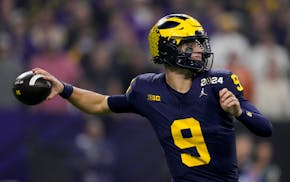I was privileged to cover Tiger Woods' one-legged U.S. Open victory last summer, as he hit laser-guided shots just before grimacing in pain.
I was privileged to walk within his vicinity during his dramatic comeback to win the 2005 Masters, and hear him dedicate the victory to his ailing father in the gloaming on Sunday night at Augusta National.
In both of those victories, he beat overmatched but game competitors, Rocco Mediate and Chris DiMarco, in playoffs. As we enter Masters week, though, I am reminded of my favorite personal Tiger moment, and it did not occur as he made a dramatic putt on the 18th hole of the Masters or limped around Torrey Pines.
My favorite Tiger Moment illuminates the golfer he has become.
Early in his career, Woods dominated because of sheer power and imagination. He could hit it farther than just about anyone else, could hit shorter irons into the green than anyone else, could pull off shots most wouldn't attempt around the greens.
This week, Woods will bring his surgically repaired left knee to Augusta National, having made a birdie putt on the 18th hole at Bay Hill to win for the first time since he limped off with the trophy at Torrey Pines. Until he made the winning birdie putt last week, though, he spent the tournament reminding us of the golfer I watched in person in 2005 at Augusta, a golfer who thrives as much because of his ability to improbably save par as his ability to make an eagle.
Once the ultimate phenom, Woods has become the ultimate grinder. I first recognized the transition on the second hole at Augusta National, during the first round in 2005.
A rain delay left Woods starting on the back nine. When he came to hole No. 2 in the late afternoon, he was struggling, having just made a bogey at No. 1 after banking a shot off the flagstick and sculling a bunker shot.
He was fuming as he stood of his tee shot. Because of the rain and unpredictable forecasts, there were fewer observers around him at this moment than perhaps at any major before or since. He stood over his tee shot on the relatively easy, downhill par-5, swung mightily, and started cussing.
Everyone looked far down the fairway, waiting for the ball to appear, then glanced back toward the tee. The ball was scuttling along the treeline on the left. He had hit a branch and advanced the ball about 150 yards, for what had to be the shortest drive of his career.
Woods kept cussing and paced to his ball. His wife, Elin, stood nearby, holding her face and muttering, "Oh, Tiger."
Woods stood over his second shot and produced a swing only a contortionist could appreciate, trying to hit a long iron around the corner and down the hill. Instead, he pushed his shot straight right, deep into the pines. Again, he started cussing, and again Elin followed behind, saying, "Oh, no, Tiger."
Blocked from any potential miracle shot to the green by a maze of trees, Woods chopped his third shot off the pine straw and back to the fairway.
Left with a longer-than-desired fourth shot to the green, Woods again misfired, landing his ball in the middle of the green, far from the front-left pin placement.
Woods had struggled all day. He was fuming. He was in danger of making consecutive bogeys. He faced a long, sidehill, hooking putt.
He drained it. He came back to win the tournament. Had he lost control of his anger, had he made the double bogey his shots indicated he deserved on the hole, he would not have been in position to force a playoff with DiMarco.
Woods earned that Masters -- and so many of his victories in the latter stages of his career -- because he refused to give up on a bad hole. Because he is without equal when facing a hole-saving, round-saving, tournament-saving, gotta-have-it par putt.
Jim Souhan can be heard Sundays from 10 a.m.-noon on AM-1500 KSTP. • jsouhan@startribune.com

Souhan: These seven plays showcase Wolves' new defensive fire

Souhan: Wolves fans made Game 1 special. Now bring on Game 2.

Souhan: Should Vikings even consider McCarthy in NFL draft?

Souhan: NAW erases Suns' lead, Game 1 advantage with big performance

